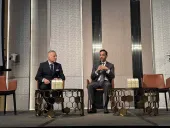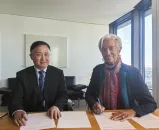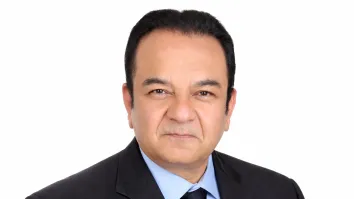
Singapore steps up efforts to boost FX ecosystem as Hong Kong closes in fast
Citi launched a pricing engine that cuts the time it takes to route a trade between Singapore to Tokyo.
When the Monetary Authority of Singapore (MAS) sounded a call for banks, startups and liquidity providers to help cement its status as a leading centre for price discovery, liquidity and transparency, Citi was one of the first players to heed the call after it announced plans to set up an electronic FX pricing and trading engine in March.
Having gone live in October 2019, Citi’s platform promises to significantly cut latency or the time in takes to execute an FX transaction by doing away with the need to route trades elsewhere.
“Prior to establishing this platform, clients would have to connect via Tokyo or one of our trading engines outside of the region. This round trip latency between Singapore and Tokyo is approximately 70 milliseconds, which is a huge difference for price discovery,” Mark Meredith, Global Head of Electronic Trading for FX and Local Markets, Citi told Asian Banking & Finance.
The engine, built in-house by Citi, includes a proprietary pricing and hedging algorithm and will initially offer 23 spot currencies (G10 and 13 deliverable EM currencies), as well as two precious metals (Gold and Silver). It marks the bank’s fourth trading location in addition to its London, New York and Tokyo infrastructure and signifies its commitment to support price discovery and trade execution during Asian trading hours.
“To support our efforts, we are also investing in a new data centre that will be focused on FX co-location, which will enable us to offer improved price transparency and facilitate more efficient price discovery in the region’s time zone for our clients,” said Meredith.
The latency challenge
The latency to London/New York is about 180 milliseconds (ms) and 85 ms to Tokyo, according to Wong Joo Seng, CEO of currency platform provider SparkSystems. To ascertain whether the order was successfully executed would take another 180 ms or 85 ms return trip, bringing the total to 360 ms and 170 ms respectively.
“If FX matching capability were to be developed in Singapore, this timing will drop to a mere 1 or so millisecond,” Wong said. “That’s an order magnitude improvement one cannot obtain by just writing a new and more optimised programme. This takes both optimisation in programming as well as infrastructure design to achieve.”
In the past 18 months, UBS, JP Morgan Chase and Standard Chartered have joined Citi in setting up similar matching engines to cater to the growing wealth in the city state. UBS’ platform has already gone live in Q2 2019 whilst JP Morgan and Standard Chartered are expected to launch in early 2020. Non-bank market makers like XTX and Jump Liquidity have grown their Singapore footholds in apparent recognition of the wealth of opportunity in the market.
Through a series of grants and tax incentives, MAS is hoping to lure another three to five major players, including non-banks and multi-dealer platforms, that can set up electronic trading platforms enabling it ‘to achieve critical mass’ over the next year, a senior MAS official was quoted in a Bloomberg interview.
"Global and regional FX players continue to expand their regional footprint in Singapore and are investing heavily in building up their skills and trading infrastructure, including in FX e-trading.
We expect these investments to bear fruit in the medium term and further improve the trading landscape for market participants and enhance price discovery, liquidity and transparency in the
Asian time zone,” Jacqueline Loh, Deputy Managing Director at MAS said in a statement.
Having multiple players set up shop is of critical importance as Tier 1 FX banks that worked on securing the necessary internal approvals and made the necessary investments would be standing still without any institutions to trade with, highlighting the challenge associated with first-mover advantage.
“Who does the institution trade with if they are first? They need to wait for the second and third etc. Hence, it needs a cluster to banks to set up matching engines here almost simultaneously for it to make any economic sense,” he said. “I think the ‘hard yards’ will be just another two to three Tier 1 FX banks. Then the floodgates should open and Singapore should develop into a major FX matching centre. This means the entire region will use Singapore as an FX hub i.e. Thailand, Malaysia, Indonesia, Philippines, Vietnam.”
Playing catch-up
Trailing only behind the UK and US, Singapore retained its position as the world’s third largest FX centre with a market share of 7.6% after average daily FX trading volumes rose 22% to $633b in April from $517b in April 2016, data from the Bank of International Settlements (BIS) show. Spot and FX swaps turnover surged 26% and 35% respectively, offsetting a 6% decline in forwards turnover. OTC interest rate derivatives market posted robust growth, with average daily volumes surging 87% to $109b from $58b three years ago.
Despite broad-based growth across G10 and emerging market currencies, Singapore’s lead over close regional competitor Hong Kong narrowed as the SAR saw average daily FX trading volume pick up at a faster clip to close at US$632b in April to rank as the fourth largest FX hub by trading volume and pulling ahead of Japan.
“The share of FX trading in the leading Asian financial centres, namely Hong Kong SAR, Singapore, and Tokyo, declined slightly to 20% in April 2019. This was mainly driven by relatively slower growth of activity in Singapore and Tokyo. Turnover in Hong Kong SAR grew at a higher rate than the global aggregate, raising its share in global turnover by one percentage point,” BIS said in its triennial central bank survey.

Source: BIS
Making headway
As Hong Kong closes in, regulators are working overtime to incentivise big players to anchor their matching and pricing engines in Singapore as they bank on the city’s low tax rates and world-class business appeal to enhance the FX ecosystem.
“Singapore is strategically positioned at the centre of Southeast Asian nations for which trade plays an important engine of economic growth. Coupled with its conducive environment that’s highly favourable to e-commerce activities, all these have enabled Singapore to attract a larger share of global investment flows and in turn helped to boost trade,” said Citi’s Meredith. "Coupled with its conducive environment that’s highly favourable to e-commerce activities, all these have enabled Singapore to attract a larger share of global investment flows and in turn helped to boost trade.”
For Wong, some of the benefits of this initiative can already be seen in recent developments. “The strategy is to help in defraying some of the costs the first few banks experience when deciding to move FX matching capabilities here. There isn’t a need to do so for the entire banking community. That would be far too costly and it’s not necessary. This only needs to be done for the first half a dozen or so movers. This [is what] the MAS has done and we are seeing the success of this initiative already.”


















 Advertise
Advertise










